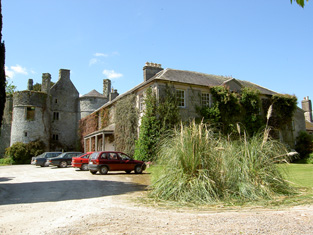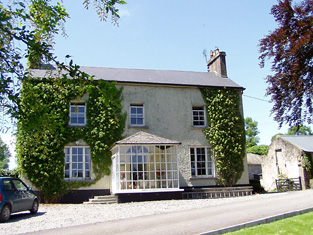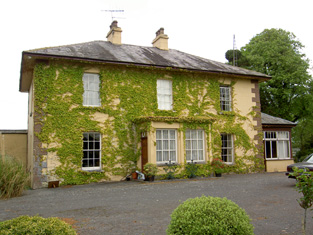Grene Park
Houses within 5km of this house
Displaying 12 houses.
Houses within 5km of Grene Park
Displaying 12 houses.
| House name | Description | |
|---|---|---|
| Ballygriffen | Taylor and Skinner record the Earl of Clanwilliam as proprietor of Ballygrifffin, Golden, in the 1770s. In 1786 Wilson refers to two properties owned by the Earl in this area "on the left of Golden is Lisheen, a seat sometimes occupied by the Earl of Clanwiliam, contiguous to which is Ballygrifin, where his lordship has a very fine range of stables and other offices". The house now at Ballygriffin is a mid 19th century house incorporating the remains of a a tower house. Occupied by Edmond [Edward] Dalton in the mid 19th century when the buildings were valued at £16.10 shillings and held from Charles Bianconi. Edward Dalton's son John Edward Dalton of Golden Hills owned 161 acres in the 1870s. |

|
| Lisheen | In 1786 Wilson writes that Lisheen was a seat sometimes occupied by the Earl of Clanwiliam. It became the seat of the Fitzgeralds, Baronets, in the 19th century, valued at £33 in the 1850s and held from the Earl of Portarlington. Edward Dalton was the tenant at the time of the sale of the Earl of Portarlington's estates in June 1856. A building is still located at this site. | |
| Clonbonane | Edmund Scully of the Silverfort branch of the Scully family lived here in the first half of the 19th century. By the time of Griffith's Valuation Jeremiah Scully held the house valued at £12 from the Earl of Norbury. This house no longer exists. | |
| Lacken | John Smithwick was resident at Lacken in 1837 and by George Smithwick in the early 1850s and held from Miss Mary Sadlier. The buildings were valued at £11. A house is still extant at the site. | |
| Ballinaclogh | A house occupied by William Scully and held by him in fee at the time of Griffith's Valuation. The buildings were valued at £11. William Scully (born 1821) of Ballinaclough was the fifth son of Denys Scully of Kilfeakle. He owned 1,354 acres in county Tipperary in the 1870s. Occupied by T.A. Scully in 1906 and valued at £16. | |
| Dundrum | Dundrum was the seat of the Viscounts Hawarden in county Tipperary in the 18th and 19th centuries. The Ordnance Survey Name Books mention that the demesne was well-planted in 1840. Dundrum was held in fee by Viscount Hawarden and valued at £85 at the time of Griffith's Valuation. The Earl de Montalt was still resident in 1906 when the house was valued at £85. The Irish Tourist Association Survey states that it was bought from the Land Commission in 1908 and became St Michael's Presentation Convent. This early 18th century Palladian house now functions as a hotel located in the grounds of the Tipperary golf club. |

|
| Kilmore | The National Inventory of Architectural Heritage dates this house from the early to mid 18th century and the Wayland family were resident at this time. Austin Cooper was living at Kilmore in 1837 and at the time of Griffith's Valuation Samuel Cooper was the occupier. He held Kilmore from the Earl of Normanstown and the buildings were valued at £16. This house is still occupied and part of a working farm. |

|
| Killenure Castle | Leet records Samuel Cooper as the proprietor of Killenure in 1814 and Lewis in 1837 as the "seat of William Cooper". At the time of Griffith's Valuation William Cooper held the property in fee and the house was valued at £31.10 shillings. The Coopers were still resident at Killenure in the early 20th century. As its webiste suggests "It has been a fortified home with sturdy towers, a'hunting box', a country house for a large family, a busy productive farm with stables and coach house, a boarding school and even a meditation centre". It will be open to the public from Summer 2012. See htp://killenure.com. |

|
| Ballywalter | F. V. Wayland was resident at Ballywalter in 1837. Francis Wayland of Ballywalter was murdered in 1838 on his way to a fair. William Weyland was living at Ballywalter in the mid 19th century, when the house was held from William Cooper and valued at £12.5 shillings. The Waylands and Coopers were related. This 18th century house is still in use as a family residence. |

|
| Ballymore House | The Murphys were established at Ballymore from the early 18th century. A castle and two houses are located in this townland at the time of Griffith's Valuation, all inhabited by members of the Murphy family. The main residence was Ballymore House, which was occupied by Edmond W. Murphy. He held the house and 423 acres from the Earl of Norbury. The buildings were valued at £24.5 shillings. Daniel Murphy also occupied a house valued at £12.5 shillings (Grid Ref S021 457). Ballymore House is still a family residence. |

|
| Woodford | John Murphy lived at Woodford in 1814 and Edmund Murphy in the mid 19th century when the house was valued at £30.15 shillings and held from Francis Greene. The Ordnance Survey Name Books describe it as "a gentleman's seat situated in a small demesne" in 1841. It is still extant. |

|
| Cappamurragh | The Grene family home occupied by John Grene in the first half of the 19th century. He held the property in fee and the buildings were valued at £24 in the early 1850s. In 1841 the Ordnance Survey Name Books describe it as "a gentleman's seat in a very handsome demesne of considerable extent". It is still extant. |

|

